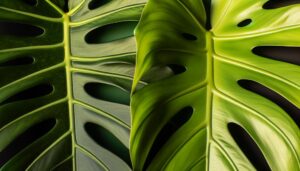Monstera Adansonii Swiss Cheese Plant: Care Guide!
You’ll love the Monstera adansonii, commonly known as the Swiss Cheese Plant, for its striking fenestrated leaves. Originating from the dense, humid rainforests of Central and South America, this member of the Araceae family climbs trees using aerial roots.
It thrives best in bright, indirect light and temperatures between 65-85°F. Make sure the soil’s top inch is dry before you water, and maintain humidity levels at 60-80%.
Use balanced liquid fertilizer during growth periods. Prune with sterilized shears and propagate with healthy stem segments.
Keeping it pest-free enhances growth—providing ideal conditions supports its extraordinary foliage.
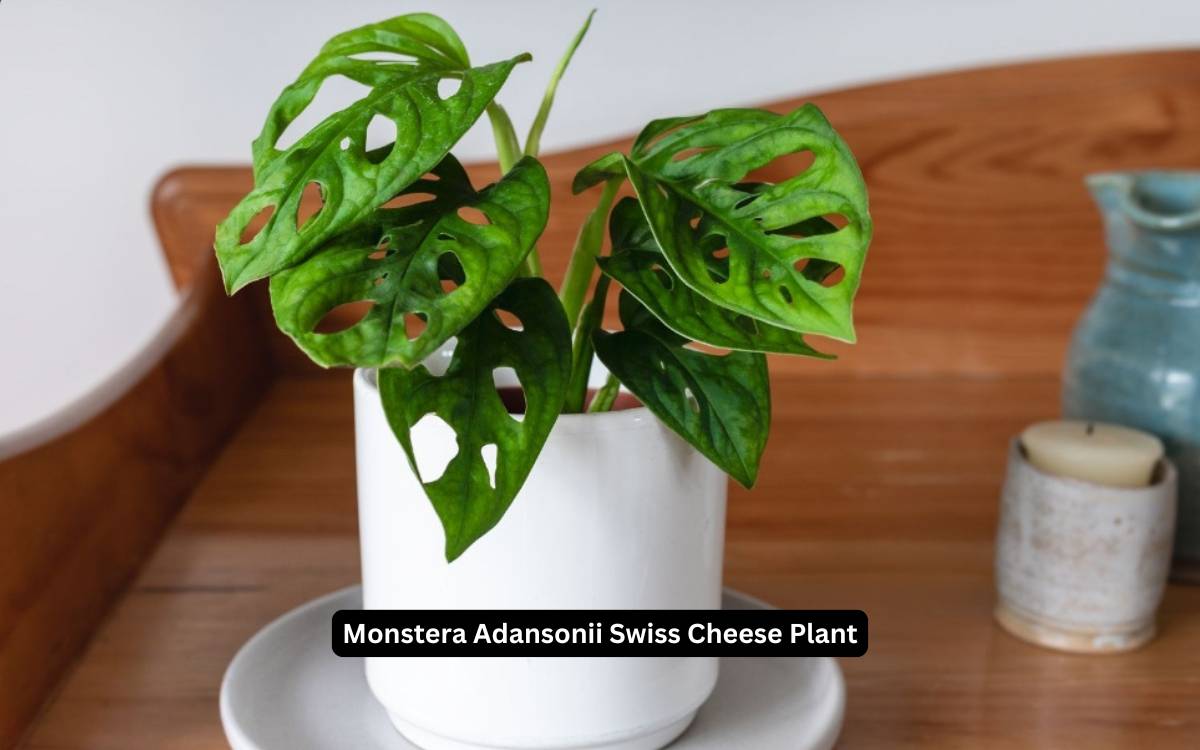
Key Takeaways
- Unique Leaf Patterns: Monstera Adansonii is known for its distinctive perforated and fenestrated leaves.
- Ideal Conditions: It thrives in bright, indirect sunlight and high humidity (60-80%) with temperatures between 65-85°F.
- Watering Needs: Water the plant when the top inch of soil is dry to the touch.
- Support and Growth: Use a moss pole or hanging planter to support its climbing growth habit.
- Pest and Disease Management: Regularly inspect for pests like spider mites and aphids, and avoid overwatering to prevent root rot.
Origins and History

Tracing its roots back to the tropical rainforests of Central and South America, Monstera adansonii, commonly known as the Swiss Cheese Plant, belongs to the Araceae family and exhibits distinctive fenestrated leaves.
You’ll find this species thriving in the understory layer of dense, humid forests, where it climbs trees using its aerial roots. Its genus, Monstera, is derived from the Latin word “monstrum,” reflecting the plant’s unusual and striking appearance.
Historically, indigenous cultures utilized Monstera adansonii for medicinal purposes and ornamental uses. Botanical explorers first documented it in the 18th century, classifying it under the Araceae family.
Understanding its origins helps you appreciate its ecological adaptability and evolutionary traits, which are essential for its survival in diverse environments.
Unique Leaf Characteristics
In addition to its fascinating history, Monstera adansonii captivates enthusiasts with its unique leaf morphology, characterized by perforations and fenestrations that maximize light capture and minimize wind resistance.
The plant’s leaves, belonging to the Araceae family, exhibit a distinctive pattern of holes (fenestrations) that are thought to replicate natural damage, deterring herbivores. These fenestrations, along with the plant’s pinnatifid (deeply lobed) leaf margins, are hypothesized to aid in the diffusion of sunlight to lower foliage, optimizing photosynthetic efficiency.
The specific epithet, adansonii, honors the French botanist Michel Adanson. As you examine these leaves, you’ll notice the adaptive traits that contribute to its survival in tropical rainforests, making it a marvel of botanical evolution and a favorite among plant enthusiasts.
Ideal Growing Conditions
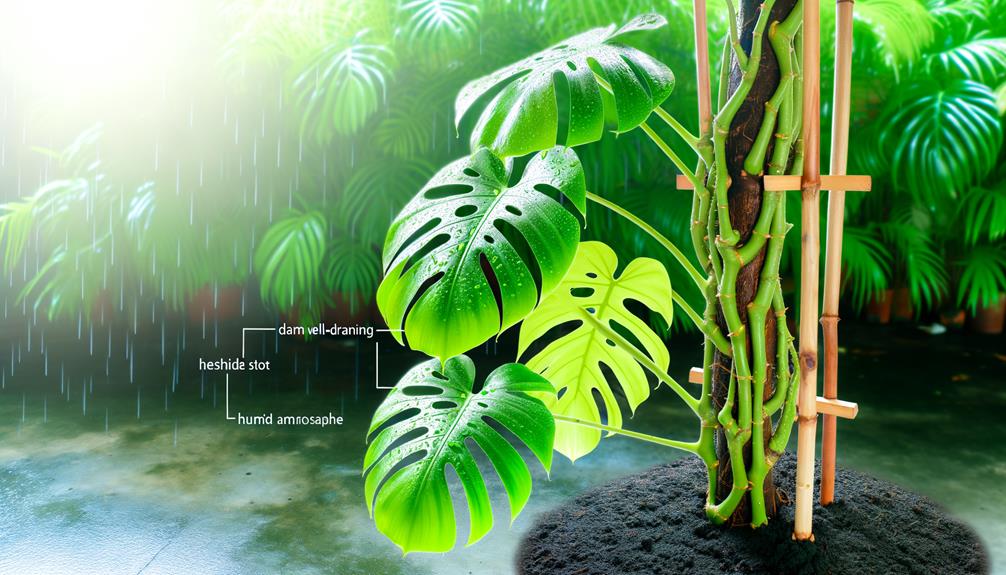
To maximize growth of your Monstera adansonii, you need to provide it with bright, indirect sunlight and maintain temperatures between 65-85°F.
Water the plant when the top inch of soil feels dry, and aim for a humidity level of 60-80%, mimicking its native tropical habitat.
Proper care in these areas will support peak growth and leaf fenestration.
Light and Temperature Needs
Monstera adansonii thrives in bright, indirect light, reflecting its native understory habitat within tropical rainforests, where dappled sunlight penetrates the dense canopy. Direct sunlight can scorch its delicate leaves, so position your plant in an area where it receives filtered light.
Best temperature ranges for Monstera adansonii are between 65°F to 80°F (18°C to 27°C). Sudden temperature fluctuations or exposure to cold drafts can stress the plant, leading to stunted growth or leaf damage. Place your Monstera adansonii away from air conditioning vents and heaters.
Watering and Humidity Tips
Regularly maintaining suitable watering levels and humidity is crucial for the best growth of Monstera adansonii. You should water this aroid when the top inch of the soil feels dry to the touch. Overwatering can lead to root rot, a common issue in Monstera species. Make sure the pot has adequate drainage to prevent waterlogging.
For ideal humidity, maintain levels between 60-80%.
Here’s how to achieve this:
- Use a humidifier: This device can maintain consistent humidity levels.
- Place a tray of water near the plant: Natural evaporation increases ambient moisture.
- Mist the leaves regularly: Light, frequent misting mimics the plant’s native tropical environment.
Following these guidelines guarantees that your Monstera adansonii thrives in its cultivated habitat.
Watering Requirements
Promoting ideal growth, Monstera adansonii requires a consistent watering schedule that maintains soil moisture without causing waterlogging. Aim to water when the top inch of soil feels dry to the touch. Overwatering can lead to root rot, a common issue for Monstera species.
Employing a moisture meter can provide accuracy in evaluating soil hydration levels. Remember, Monstera adansonii prefers high humidity environments, mimicking its native tropical habitats. You can increase local humidity by misting the foliage or using a humidifier.
During the growing season, typically spring to summer, expect to water more frequently. Conversely, reduce watering in the dormant period, usually fall to winter. This balance helps promote robust growth and prevents common watering-related issues.
Soil and Potting
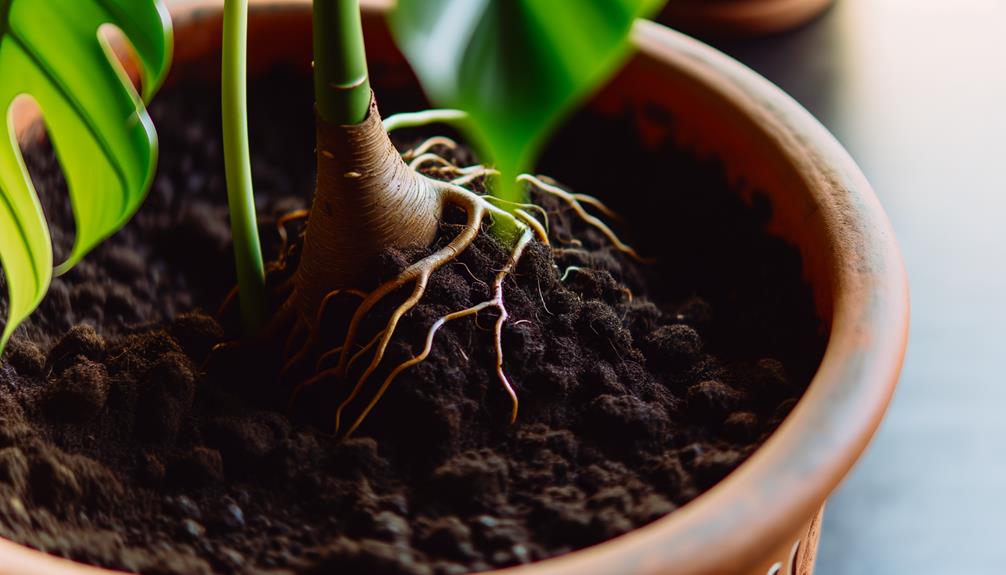
For best growth, you should plant Monstera adansonii in a well-draining, peat-based potting mix that mimics its natural epiphytic habitat. This tropical plant, belonging to the Araceae family, thrives in substrates that allow aeration and moisture retention.
To achieve this balance, consider incorporating:
- Orchid bark: Enhances aeration and mimics tree-bark climbing surfaces.
- Perlite: Improves drainage and prevents root decay.
- Coco coir: Retains moisture while offering a fibrous structure.
Using a container with drainage holes is crucial to avoid waterlogging, which can lead to root decay in Monstera adansonii. Repotting every 1-2 years ensures the plant has sufficient space for growth and nutrient uptake. Keep in mind, a slightly root-bound Monstera can still flourish under optimal conditions.
Fertilization Tips
To maximize Monstera adansonii‘s growth, you’ll need to establish a prime feeding schedule, typically every 4-6 weeks during the growing season.
Use a balanced, water-soluble fertilizer rich in macronutrients like nitrogen, phosphorus, and potassium.
Adjust fertilization frequency and type based on seasonal growth patterns, reducing feed during dormancy to prevent nutrient overload.
Optimal Feeding Schedule
Feeding your Monstera adansonii with a balanced, water-soluble fertilizer every 4-6 weeks during its growing season guarantees robust growth and vibrant foliage. This species, from the Araceae family, thrives with consistent nutrient input. Apply the fertilizer at half strength to avoid root burn and over-fertilization.
Remember to:
- Check Soil Moisture: Confirm the soil is damp before application to facilitate nutrient absorption.
- Monitor Seasonal Changes: Reduce feeding frequency during fall and winter when the plant enters dormancy.
- Observe Plant Response: Look for signs of nutrient deficiency, such as yellowing leaves, and adjust the feeding schedule accordingly.
Best Fertilizer Types
Selecting the appropriate fertilizer type for your Monstera adansonii guarantees it receives the precise nutrients it needs for optimal growth and health. Opt for a balanced, water-soluble fertilizer with an NPK ratio of 20-20-20.
This guarantees macronutrient harmony, essential for strong vegetative development and root reinforcement. Alternatively, slow-release granular fertilizers provide a consistent nutrient supply, reducing the risk of over-fertilization.
Here’s a comparison to guide your choice:
| Fertilizer Type | Advantages | Disadvantages |
|---|---|---|
| Water-soluble (20-20-20) | Immediate nutrient availability | Requires frequent application |
| Slow-release granular | Long-lasting, reduced risk | Potential under-fertilization |
| Organic compost | Enhances soil structure | Nutrient release variability |
Choosing the proper fertilizer secures your Monstera adansonii, a member of the Araceae family, flourishes with lush foliage and robust growth.
Seasonal Fertilization Needs
Understanding the seasonal fertilization needs of your Monstera adansonii is important for ensuring its year-round health and strength.
During the active growth phase, typically spring and summer, apply a balanced liquid fertilizer every other week to support vigorous foliar development and root expansion.
In autumn, reduce the frequency to monthly as the plant shifts to dormancy.
Winter requires minimal fertilization, perhaps once every two months, to prevent nutrient overload and root burn.
Key points to remember:
- Spring/Summer: Every other week application of balanced liquid fertilizer.
- Autumn: Monthly feeding to ease into dormancy.
- Winter: Sparse fertilization, once every two months.
Pruning and Propagation
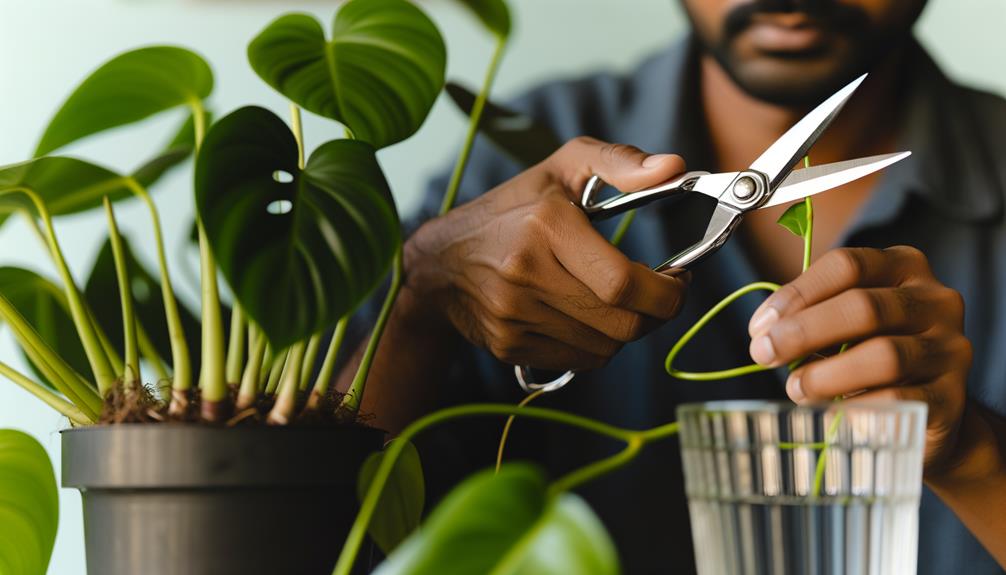
To sustain the health and aesthetic appeal of your Monstera adansonii, precise trimming and effective reproduction are crucial practices. Trimming involves removing aging or damaged leaves, which promotes new growth and maintains the plant’s fenestrated leaf structure. Use sterilized trimming shears to cut just above a node.
For reproduction, select a healthy stem segment containing at least one node and aerial root. Place the cutting in water or a well-draining substrate until roots develop. This method, known as vegetative reproduction, guarantees genetic consistency with the parent plant.
Regular trimming also helps control size and shape, preventing your Monstera adansonii from becoming leggy. Always monitor humidity and light levels to support optimal growth conditions post-reproduction.
Common Pests and Diseases
Many Monstera adansonii owners encounter common pests like spider mites (Tetranychidae) and aphids (Aphididae), as well as diseases such as root rot caused by overwatering. Vigilance is essential to maintain plant health.
Spider mites, barely visible to the naked eye, create fine webs and cause stippling on leaves. Aphids, small and often green, feed on sap, leading to distorted growth. Root rot, resulting from excessive moisture, causes root decay and yellowing leaves.
Key steps to prevent and treat these issues include:
- Maintain proper humidity: High humidity deters spider mites.
- Inspect regularly: Early detection of aphids and mites prevents infestations.
- Avoid overwatering: Make sure soil drains well to prevent root rot.
These measures help keep your Monstera adansonii thriving.
Decorating With Monstera Adansonii

Incorporating Monstera adansonii into your decor can enhance interior aesthetics with its unique fenestrated leaves and vibrant green hues. The distinctive perforations in the leaf blades, known as fenestrations, are a hallmark of this species, classified under the Araceae family.
Place these epiphytic climbers in well-lit areas to optimize their photosynthetic activity and maintain their chlorophyll-rich foliage. You can use a moss pole to support vertical growth, allowing the aerial roots to anchor and absorb moisture. Alternatively, let it cascade from a hanging planter, creating a verdant focal point.
Remember to balance humidity and indirect light to simulate its native tropical understory habitat. This strategic placement not only beautifies but also enriches your living space’s biodiversity.
Conclusion
Caring for Monstera adansonii, with its enchanting fenestrated leaves and manageable care requirements, offers a rewarding blend of elegance and simplicity.
While its epiphytic nature harks back to tropical rainforests, your home provides the perfect sanctuary. Balancing its need for indirect light, well-draining soil, and precise watering juxtaposes the plant’s wild origins with your cultivated space.
Embrace this Araceae family gem, and you’ll witness a harmonious interplay of nature and nurture in your living environment.



